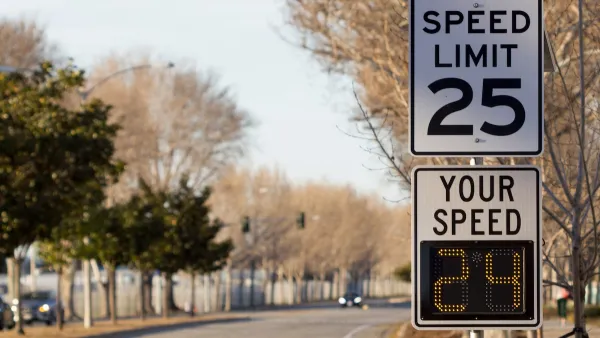Dedicated bus lanes on busy arterials can act as traffic calming mechanisms to reduce speeding.

A new study reveals that dedicated bus lanes have the additional benefit of improving overall road safety, writes Chris McCahill for State Smart Transportation Initiative.
In Albuquerque, a team of researchers found that traffic speeds dropped significantly along corridors with bus rapid transit (BRT) infrastructure, making it an “especially effective” tool to curb speeding. “The effects were largest at intersections along the BRT route and in places where the number of general-purpose lanes was reduced. Average vehicle speeds dropped by around 15% when there was a lane reduction, versus 10% at other locations, and 85th percentile speeds dropped by 12% to 14%, versus 8% at other locations.” The study notes that speeds did not change much on roads with the fastest posted speed limit (40 mph).
The authors add that other studies have shown similar effects from bike lanes, trees, and other design cues. The findings are important because major arterial roads are often inappropriate for typical traffic calming interventions. “Converting arterial corridors to more multimodal arrangements can provide road users with mobility options while simultaneously improving safety outcomes.”
FULL STORY: Dedicated bus lanes improve safety

Planetizen Federal Action Tracker
A weekly monitor of how Trump’s orders and actions are impacting planners and planning in America.

Maui's Vacation Rental Debate Turns Ugly
Verbal attacks, misinformation campaigns and fistfights plague a high-stakes debate to convert thousands of vacation rentals into long-term housing.

San Francisco Suspends Traffic Calming Amidst Record Deaths
Citing “a challenging fiscal landscape,” the city will cease the program on the heels of 42 traffic deaths, including 24 pedestrians.

Defunct Pittsburgh Power Plant to Become Residential Tower
A decommissioned steam heat plant will be redeveloped into almost 100 affordable housing units.

Trump Prompts Restructuring of Transportation Research Board in “Unprecedented Overreach”
The TRB has eliminated more than half of its committees including those focused on climate, equity, and cities.

Amtrak Rolls Out New Orleans to Alabama “Mardi Gras” Train
The new service will operate morning and evening departures between Mobile and New Orleans.
Urban Design for Planners 1: Software Tools
This six-course series explores essential urban design concepts using open source software and equips planners with the tools they need to participate fully in the urban design process.
Planning for Universal Design
Learn the tools for implementing Universal Design in planning regulations.
Heyer Gruel & Associates PA
JM Goldson LLC
Custer County Colorado
City of Camden Redevelopment Agency
City of Astoria
Transportation Research & Education Center (TREC) at Portland State University
Jefferson Parish Government
Camden Redevelopment Agency
City of Claremont





























